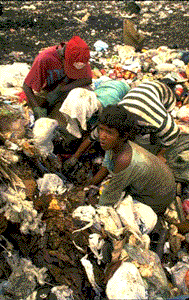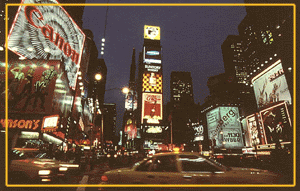|
● Racial Problems
● Poverty
● Drug Abuse
● Crime
● The Abuse of Power
by Government and Corporations
Poverty
 By
many standards the United States is the most fabulously wealthy
society in history. Yet over 24 million people, more than 1 American
in 10, are living at or below the official poverty line, on incomes
that the federal government considers insufficient to meet basic
requirement of food, clothing, and shelter. These people are not
the only poor in the United States; there are millions more, living
slightly above the poverty line, whose plight is not much
better. Despite our celebrated affluence, social services
in the United States compare unfavorably with those in most industrialized
societies. Furthermore, the affluent majority sometimes seems indifferent
to the problems of the poorest section of the population. By
many standards the United States is the most fabulously wealthy
society in history. Yet over 24 million people, more than 1 American
in 10, are living at or below the official poverty line, on incomes
that the federal government considers insufficient to meet basic
requirement of food, clothing, and shelter. These people are not
the only poor in the United States; there are millions more, living
slightly above the poverty line, whose plight is not much
better. Despite our celebrated affluence, social services
in the United States compare unfavorably with those in most industrialized
societies. Furthermore, the affluent majority sometimes seems indifferent
to the problems of the poorest section of the population.
 |
|
Poverty in the United States
|
 Poverty
in the United States does not simply mean that the poor do not live
quite as well as other citizens. It means many old people eating
dog and cat food to supplement
their diets.
It means malnutrition
and deprivation
for hundreds of thousands of children. It means greater susceptibility
to disease, to alcoholism,
to victimization
by criminals, and to mental disorders. It often means unstable marriages,
slum
housing, illiteracy,
ignorance, inadequate medical facilities, and shortened life expectancy.
Poverty can mean low self-esteem,
despair, and stunting
of human potential. Poverty
in the United States does not simply mean that the poor do not live
quite as well as other citizens. It means many old people eating
dog and cat food to supplement
their diets.
It means malnutrition
and deprivation
for hundreds of thousands of children. It means greater susceptibility
to disease, to alcoholism,
to victimization
by criminals, and to mental disorders. It often means unstable marriages,
slum
housing, illiteracy,
ignorance, inadequate medical facilities, and shortened life expectancy.
Poverty can mean low self-esteem,
despair, and stunting
of human potential.
 The
problem of poverty in the United States is aggravated
because it occurs in a society in which the overall distribution
of wealth (property and other capital) and income (wages, salaries,
and other earnings) is very unequal. Like all but the simplest societies,
the United States is characterized by social stratification, that
is, it
is divided into social classes that have varying degrees of access
to the rewards the society offers. It was estimated in
the 1970s that if the wealth in the United States were evenly distributed,
every adult would have a net worth of around $25000. But, the distribution
of wealth is highly unequal. The richlack workers run as high as
50%, or about 8 times the rate for the American work force as a
whole. This "underclass" could continue to persist, even
in the absence of racial discrimination, in much the same way as
other pockets of poverty persist—that is, for reasons of social-class
inequality. In any event, such progress as has been made in the
past decade has brought no benefit whatever to the black "underclass",
who are living in an environment of poverty, decay, crime, drug
addiction, joblessness, and hopelessness. Most
of this wealth has not been accumulated
through
the hard work or imaginative
skills
of those who now enjoy it. It has been inherited. Just
as the children of the poor are born into poverty and tend to remain
there, so the children of the rich tend to enjoy a lifetime of affluence. The
problem of poverty in the United States is aggravated
because it occurs in a society in which the overall distribution
of wealth (property and other capital) and income (wages, salaries,
and other earnings) is very unequal. Like all but the simplest societies,
the United States is characterized by social stratification, that
is, it
is divided into social classes that have varying degrees of access
to the rewards the society offers. It was estimated in
the 1970s that if the wealth in the United States were evenly distributed,
every adult would have a net worth of around $25000. But, the distribution
of wealth is highly unequal. The richlack workers run as high as
50%, or about 8 times the rate for the American work force as a
whole. This "underclass" could continue to persist, even
in the absence of racial discrimination, in much the same way as
other pockets of poverty persist—that is, for reasons of social-class
inequality. In any event, such progress as has been made in the
past decade has brought no benefit whatever to the black "underclass",
who are living in an environment of poverty, decay, crime, drug
addiction, joblessness, and hopelessness. Most
of this wealth has not been accumulated
through
the hard work or imaginative
skills
of those who now enjoy it. It has been inherited. Just
as the children of the poor are born into poverty and tend to remain
there, so the children of the rich tend to enjoy a lifetime of affluence.
 The
distribution of income in the United States follows a similar pattern.
The richest fifth of American families receives over 40% of the
national income, whereas the poorest fifth receives only 5.2%. This
pattern has remained virtually unchanged at least since World War
II. About 3000 families receive, in addition to whatever wealth
they may possess, an annual income of over $ 1 million, most of
it from investments.
The highest executives of major corporations enjoy staggering
salaries. A 1979 Industrial Conference Board report showed that
the heads of the nation's major manufacturing corporations earned
an average of $241 000 a year. Corporate
executives enjoy many other tax-free
benefits
from their companies, such as the use of cars and private jets,
expense accounts, medical care, and vacations disguised
as business trips. These untaxed benefits can easily represent the
equivalent of hundreds or even thousands of dollars of income every
month. It was found that 80% of the checks
at the most expensive restaurants and over a third of Broadway
theater tickets were covered by expense accounts. The
distribution of income in the United States follows a similar pattern.
The richest fifth of American families receives over 40% of the
national income, whereas the poorest fifth receives only 5.2%. This
pattern has remained virtually unchanged at least since World War
II. About 3000 families receive, in addition to whatever wealth
they may possess, an annual income of over $ 1 million, most of
it from investments.
The highest executives of major corporations enjoy staggering
salaries. A 1979 Industrial Conference Board report showed that
the heads of the nation's major manufacturing corporations earned
an average of $241 000 a year. Corporate
executives enjoy many other tax-free
benefits
from their companies, such as the use of cars and private jets,
expense accounts, medical care, and vacations disguised
as business trips. These untaxed benefits can easily represent the
equivalent of hundreds or even thousands of dollars of income every
month. It was found that 80% of the checks
at the most expensive restaurants and over a third of Broadway
theater tickets were covered by expense accounts.
 |
|
Broadway Meets Time Square
|
 The
continued existence of poverty in a generally affluent American
society raises serious moral questions—and inevitably
creates fierce conflicts of interest and many political controversies. The
continued existence of poverty in a generally affluent American
society raises serious moral questions—and inevitably
creates fierce conflicts of interest and many political controversies.
Previous Page Next
Page
|

